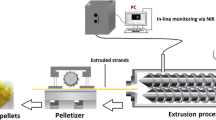Abstract
This pre-formulation study assays the capacity of the polyesteramide PADAS, poly (L-alanine-dodecanediol-L-alanine-sebacic), as an insoluble tablet excipient matrix for prolonged drug release. The flow properties of PADAS were suitable for tableting, and the compressibility of tablets containing exclusively PADAS was evaluated by ESEM observation of the microstructure. The tablets were resistant to crushing and non-friable and they did not undergo disintegration (typical features of an inert matrix). Tablets containing 33.33% sodium diclofenac (DF), ketoprofen (K) or dexketoprofen trometamol (DK-T) as a model drug, in addition with 66.67% of polymer, were formulated, and the absence of interactions between the components was confirmed by differential scanning calorimetry. Dissolution tests showed that PADAS retained DF and K and prolonged drug release, following a Higuchi kinetic. The tablets containing DK-T did not retain the drug sufficiently for prolonged release to be established. Tablets containing DK-T and 66.67, 83.33 or 91.67% PADAS, compressed at 44.48 or 88.96 kN, were elaborated to determine the influence of the polymer amount and of the compression force on DK-T release. Both parameters significantly delayed drug release, except when the proportion of polymer was 91.67%.







Similar content being viewed by others
REFERENCES
Rodríguez-Galán A, Franco L, Puiggalí J. Biodegradable poly (ester amide) s: synthesis and applications. In: Felton GP (ed). Biodegradable polymers: processing, degradation and applications. 2011a; 207–272.
Rodríguez-Galán A, Franco L, Puiggali J. Degradable poly(esteramide)s for biomedical applications. Polymers. 2011b;3:65–99.
Tarvairen T, Karjalainen T, Malin M, Phojolainen S, Tuominen J, Seppala J, et al. Degradation of and drug release from a novel 2,2-bis (2-oxazoline) linked poly (lactic acid) polymer. J Control Release. 2002;81:251–61.
Tarvairen T, Malin M, Barragan I, Tuominen J, Seppala J, Jarvinen K. Effects of incorporated drugs on degradation of a novel 2,2-bis (2-oxazoline) linked poly (lactic acid) films. Int J Pharm. 2006;310:162–7.
Andrés-Guerrero V, Zong M, Ramsay E, Rojas B, Sharkel S, Gallego B, et al. Novel biodegradable polyesteramide microspheres for controlled drug delivery in ophthalmology. J Control Release. 2015;211:105–17.
Raviña-Eirín E, Sánchez-Rodríguez B, Gómez-Amoza JL, Martínez-Pacheco R. Evaluation of the hyperbranched polymer Hybrane H1500 for production of matricial controlled-release particles by hot-melt extrusion. Int J Pharm. 2004;461:469–77.
Praphakara RA, Munusamyb MA, Sadasivunic KK, Rajana M. Targeted delivery of rifampicin to tuberculosis-infected macrophages: design, in-vitro, and in-vivo performance of rifampicin-loaded poly (ester amide)s nanocarriers. Int J Pharm. 2016;513:628–35.
Basu A, Kunduru KR, Katzhendler J, Domb AJ. Poly (α-hydroxy acid)s and poly(α-hydroxy acid-co-α-amino acid)s derived from amino acid. Adv Drug Deliv Rev. 2016;107:82–96.
Paredes N, Rodríguez-Galán A, Puiggalí J, Peraire C. Studies on the biodegradation and biocompatibiliy of a new poly(ester amide) derived from L-alanine. J Appl Polym Sci. 1998;69:1537–49.
Vera M, Puiggalí J, Coudane J. Microspheres from new biodegradable poly(ester amide)s with different ratios of L- and D-alanine for controlled drug delivery. J Microencapsul. 2006;23:686–97.
Del Valle LJ, Roca D, Franco L, Puiggalí J, Rodríguez-Galán A. Preparation and release study of ibuprofen-loaded porous matrices of a biodegradable poly(ester amide) derived from L-alanine units. J Appl Polym Sci. 2011;122:1953–67.
Del Valle LJ, Roa M, Díaz A, Casas MT, Puiggalí J, Rodríguez-Galán A. Electrospun nanofibers of a degradable poly(ester amide). Scaffolds loaded with antimicrobial agents. J Polym Res. 2012;19:9792.
Grund S, Bauer M, Fischer D. Polymers in drug delivery. State of the art and future trends. Adv Eng Mater. 2011;13(3):B61–87. WILEY-VCH Verlag GmbH & Co. KGaA, Weinheim
Park K. Controlled drug delivery systems: past forward and future back. J Control Release. 2014;190:3–8.
Anselmo AC, Mitragotri S. An overview of clinical and commercial impact of drug delivery systems. J Control Release. 2014;190:15–28.
US Pharmacopoeia. The United States Pharmacopoeial Convention. Rockville 2014.
Costa P, Sousa JM. Modeling and comparison of dissolution profiles. Eur J Pharm Sci. 2001;13:123–33.
Palomo ME, Ballesteros MP, Frutos P. Analysis of diclofenac sodium and derivates. J Pharm Biomed Anal. 1999;21:83–94.
Jelvehgari M, Barar J, Valizadeh H, Delf B, Ziapour M. Preparation of diclofenac sodium composite microparticles with improved initial release property. Trans F Nanotechnol Scientia Iranica. 2010;17(2):79–89.
Álvarez C. Influence of enantiomorphism on the solubility and dissolution rate of different racemic drugs. University Complutense of Madrid: Doctoral thesis; 2002.
Amit K, Mahalaxmi R, Srinivas P, Deepak K. Enhancement of solubility and dissolution of poorly soluble drug: Ketoprofen as a model drug. J Chem Pharm Res. 2011;3(1):268–76.
Alcalá M. Utilization of spectroscopy NIR on the analytical control in pharmaceutics field. Developments starting in ATP. Universitat Autónoma of Barcelona: Doctoral thesis; 2006.
Blanco M, Alcalá M, González J, Torras E. Near infrared spectroscopy in the study of polymorphic transformations. Anal Chim Acta. 2006;567:262–8.
Villanova JCO, Ayresb E, Oréfice RL. Design of prolonged release tablets using new solid acrylic excipients for direct compression. Eur J Pharm Biopharm. 2011;79:664–73.
Reza MS, Quadir MA, Haider SS. Development of theophylline sustained release dosage form based on kollidon SR. Pak J Pharm Sci. 2002;15:63–70.
Ferrero C, Jiménez-Castellanos MR. In vitro release testing of matrices based on starch–methyl methacrylate copolymers: effect of tablet crushing force, dissolution medium pH and stirring rate. Int J Pharm. 2014;461:270–9.
Hiremath SP, Saha RN. Design and study of rifampicin oral controlled release formulations. Drug Deliv. 2004;11:311–7.
Casas M, Ferrero C, Jiménez-Castellanos MR. Graft tapioca starch copolymers as novel excipients for controlled-release matrix tablets. Carbohydr Polym. 2010;80:71–7.
Reza MS, Quadir MA, Haider SS. Comparative evaluation of plastic, hydrophobic and hydrophilic polymers as matrices for controlled-release drug delivery. J Pharm Pharm Sci. 2003;6:282–91.
Grund J, Koerber M, Bodmeier R. Predictability of drug release from water-insoluble polymeric matrix tablets. Eur J Pharm Biopharm. 2013;85:650–5.
Author information
Authors and Affiliations
Corresponding author
Rights and permissions
About this article
Cite this article
Bonillo Martínez, A.D., Galán, I.C.R. & Bellver, M.V.M. Application of a Biodegradable Polyesteramide Derived from L-Alanine as Novel Excipient for Controlled Release Matrix Tablets. AAPS PharmSciTech 18, 3286–3295 (2017). https://doi.org/10.1208/s12249-017-0809-y
Received:
Accepted:
Published:
Issue Date:
DOI: https://doi.org/10.1208/s12249-017-0809-y




